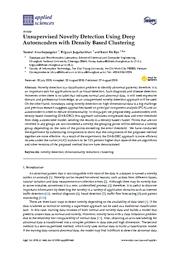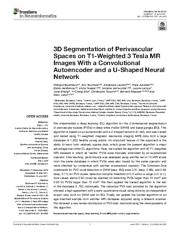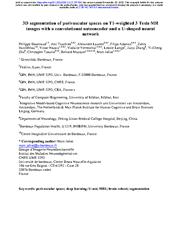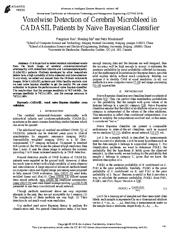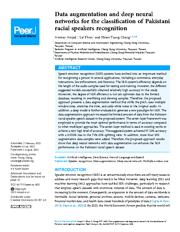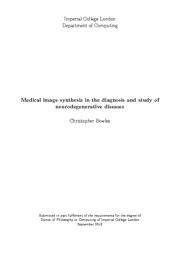A copy of this work was available on the public web and has been preserved in the Wayback Machine. The capture dates from 2019; you can also visit the original URL.
The file type is application/pdf.
Filters
Unsupervised Novelty Detection Using Deep Autoencoders with Density Based Clustering
2018
Applied Sciences
In this paper, we propose deep autoencoders with density based clustering (DAE-DBC); this approach calculates compressed data and error threshold from deep autoencoder model, sending the results to a density ...
Novelty detection is a classification problem to identify abnormal patterns; therefore, it is an important task for applications such as fraud detection, fault diagnosis and disease detection. ...
Conflicts of Interest: The authors declare no conflict of interest. Appl. Sci. 2018, 8, 1468 ...
doi:10.3390/app8091468
fatcat:u5ljyjnnjrgrzkcdz27t4jqfkm
3D Segmentation of Perivascular Spaces on T1-Weighted 3 Tesla MR Images With a Convolutional Autoencoder and a U-Shaped Neural Network
2021
Frontiers in Neuroinformatics
This algorithm is based on an autoencoder and a U-shaped network (U-net), and was trained and tested using T1-weighted magnetic resonance imaging (MRI) data from a large database of 1,832 healthy young ...
We implemented a deep learning (DL) algorithm for the 3-dimensional segmentation of perivascular spaces (PVSs) in deep white matter (DWM) and basal ganglia (BG). ...
" file: TPR, PPV, and Dice-Sorensen metrics for PVSs located in the DWM and the BG are provided at 9 amplitude thresholds of the prediction map threshold (PredMap-Thr, 0.1 to 0.9 in steps of 0.1) and cluster ...
doi:10.3389/fninf.2021.641600
pmid:34262443
pmcid:PMC8273917
fatcat:ekrdecvs2bbvzgzywbcdev2agu
3D segmentation of perivascular spaces on T1-weighted 3 Tesla MR images with a convolutional autoencoder and a U-shaped neural network
[article]
2020
bioRxiv
pre-print
This algorithm is based on an autoencoder and a U-shaped network (U-net), and was trained and tested using T1-weighted magnetic resonance imaging (MRI) data from a large database of 1,832 healthy young ...
We implemented a deep learning (DL) algorithm for the 3-dimensional segmentation of perivascular spaces (PVSs) in deep white matter (DWM) and basal ganglia (BG). ...
This can be achieved either by retraining the neural network for each database or by applying the neural network previously trained on one dataset to the other datasets. ...
doi:10.1101/2020.11.25.397364
fatcat:s5frywlnlnbptfhwz7rdbplg7a
Voxelwise Detection of Cerebral Microbleed in CADASIL Patients by Naive Bayesian Classifier
2018
Proceedings of the 2018 International Conference on Information Technology and Management Engineering (ICITME 2018)
unpublished
It is important to detect cerebral microbleed voxels from the brain image of cerebral autosomal-dominant arteriopathy with subcortical infarcts and Leukoencephalopathy (CADASIL) patients. ...
In our study, we collect our dataset from the 20 brain volumetric images, 10 for CADASIL patients and 10 for healthy controls. And we used naive baysian classifier to get the results. ...
Chen (2016) [3] utilized sparse deep neural network. Hou (2018) [4] employed autoencoder. Jiang (2017) [5] used rank-based average pooling. ...
doi:10.2991/icitme-18.2018.35
fatcat:unhaaqvzcbedjlbwfgikoocrhe
Data augmentation and deep neural networks for the classification of Pakistani racial speakers recognition
2022
Therefore, the proposed approach results show that deep neural networks with data augmentation can enhance the SER performance on the Pakistani racial speech dataset. ...
In addition, a deep model is further evaluated to generate a new paradigm for SER. ...
Seven-layer deep neural network based on sparse autoencoder for voxelwise detection of cerebral microbleed. Multimedia Tools and Applications 77(9):10521-10538 DOI 10.1007/s11042-017-4554-8. ...
doi:10.7717/peerj-cs.1053
pmid:36091976
pmcid:PMC9454772
fatcat:txxmpztovrf2jci3zc7qqlzhkm
Medical image synthesis in the diagnosis and study of neurodegenerative diseases
2019
A method for synthesising subject-specific non-pathological images from pathological images is first proposed and used for the unsupervised brain lesion segmentation. ...
We next show how generative adversarial networks (GANs) can be used to both analyse the structural changes seen in patients with Alzheimer's disease, and to add or remove these changes from patient images ...
These transformations take the form of a deep neural network which is learned using real training examples. ...
doi:10.25560/74457
fatcat:qc25mwojobb37pfijvwbtyyr4e

